Salvatore D'Oro
AgentRAN: An Agentic AI Architecture for Autonomous Control of Open 6G Networks
Aug 25, 2025
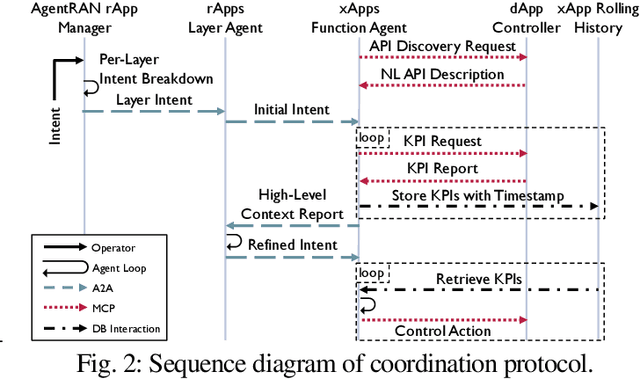


Abstract:The Open RAN movement has catalyzed a transformation toward programmable, interoperable cellular infrastructures. Yet, today's deployments still rely heavily on static control and manual operations. To move beyond this limitation, we introduce AgenRAN, an AI-native, Open RAN-aligned agentic framework that generates and orchestrates a fabric of distributed AI agents based on Natural Language (NL) intents. Unlike traditional approaches that require explicit programming, AgentRAN's LLM-powered agents interpret natural language intents, negotiate strategies through structured conversations, and orchestrate control loops across the network. AgentRAN instantiates a self-organizing hierarchy of agents that decompose complex intents across time scales (from sub-millisecond to minutes), spatial domains (cell to network-wide), and protocol layers (PHY/MAC to RRC). A central innovation is the AI-RAN Factory, an automated synthesis pipeline that observes agent interactions and continuously generates new agents embedding improved control algorithms, effectively transforming the network from a static collection of functions into an adaptive system capable of evolving its own intelligence. We demonstrate AgentRAN through live experiments on 5G testbeds where competing user demands are dynamically balanced through cascading intents. By replacing rigid APIs with NL coordination, AgentRAN fundamentally redefines how future 6G networks autonomously interpret, adapt, and optimize their behavior to meet operator goals.
Beyond Connectivity: An Open Architecture for AI-RAN Convergence in 6G
Jul 09, 2025Abstract:The proliferation of data-intensive Artificial Intelligence (AI) applications at the network edge demands a fundamental shift in RAN design, from merely consuming AI for network optimization, to actively enabling distributed AI workloads. This paradigm shift presents a significant opportunity for network operators to monetize AI at the edge while leveraging existing infrastructure investments. To realize this vision, this article presents a novel converged O-RAN and AI-RAN architecture that unifies orchestration and management of both telecommunications and AI workloads on shared infrastructure. The proposed architecture extends the Open RAN principles of modularity, disaggregation, and cloud-nativeness to support heterogeneous AI deployments. We introduce two key architectural innovations: (i) the AI-RAN Orchestrator, which extends the O-RAN Service Management and Orchestration (SMO) to enable integrated resource and allocation across RAN and AI workloads; and (ii) AI-RAN sites that provide distributed edge AI platforms with real-time processing capabilities. The proposed system supports flexible deployment options, allowing AI workloads to be orchestrated with specific timing requirements (real-time or batch processing) and geographic targeting. The proposed architecture addresses the orchestration requirements for managing heterogeneous workloads at different time scales while maintaining open, standardized interfaces and multi-vendor interoperability.
5G Aero: A Prototyping Platform for Evaluating Aerial 5G Communications
Jun 10, 2025Abstract:The application of small-factor, 5G-enabled Unmanned Aerial Vehicles (UAVs) has recently gained significant interest in various aerial and Industry 4.0 applications. However, ensuring reliable, high-throughput, and low-latency 5G communication in aerial applications remains a critical and underexplored problem. This paper presents the 5th generation (5G) Aero, a compact UAV optimized for 5G connectivity, aimed at fulfilling stringent 3rd Generation Partnership Project (3GPP) requirements. We conduct a set of experiments in an indoor environment, evaluating the UAV's ability to establish high-throughput, low-latency communications in both Line-of-Sight (LoS) and Non-Line-of-Sight (NLoS) conditions. Our findings demonstrate that the 5G Aero meets the required 3GPP standards for Command and Control (C2) packets latency in both LoS and NLoS, and video latency in LoS communications and it maintains acceptable latency levels for video transmission in NLoS conditions. Additionally, we show that the 5G module installed on the UAV introduces a negligible 1% decrease in flight time, showing that 5G technologies can be integrated into commercial off-the-shelf UAVs with minimal impact on battery lifetime. This paper contributes to the literature by demonstrating the practical capabilities of current 5G networks to support advanced UAV operations in telecommunications, offering insights into potential enhancements and optimizations for UAV performance in 5G networks
LibIQ: Toward Real-Time Spectrum Classification in O-RAN dApps
May 15, 2025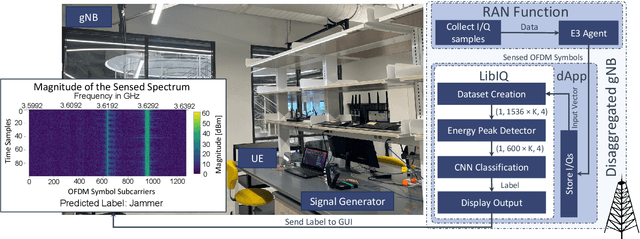
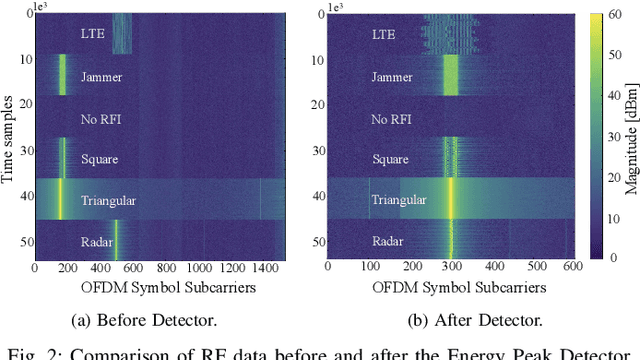
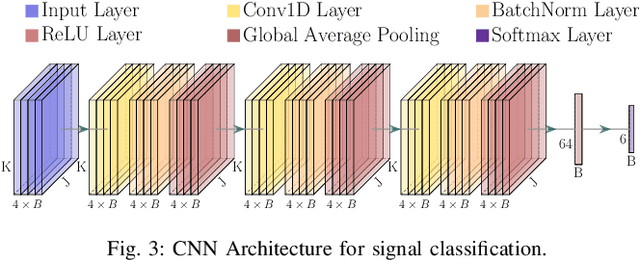
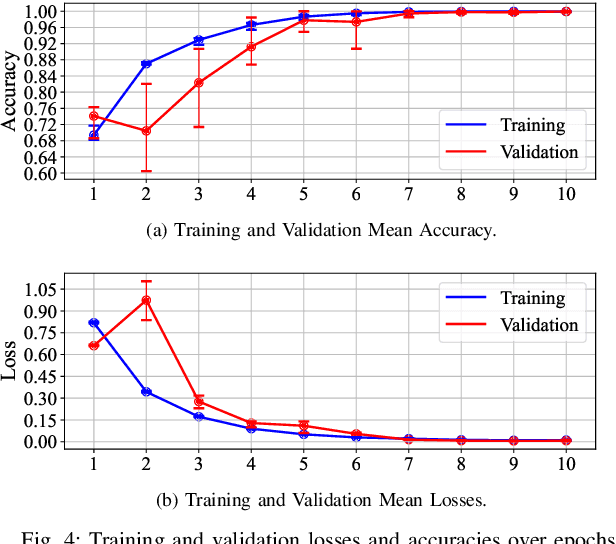
Abstract:The O-RAN architecture is transforming cellular networks by adopting RAN softwarization and disaggregation concepts to enable data-driven monitoring and control of the network. Such management is enabled by RICs, which facilitate near-real-time and non-real-time network control through xApps and rApps. However, they face limitations, including latency overhead in data exchange between the RAN and RIC, restricting real-time monitoring, and the inability to access user plain data due to privacy and security constraints, hindering use cases like beamforming and spectrum classification. In this paper, we leverage the dApps concept to enable real-time RF spectrum classification with LibIQ, a novel library for RF signals that facilitates efficient spectrum monitoring and signal classification by providing functionalities to read I/Q samples as time-series, create datasets and visualize time-series data through plots and spectrograms. Thanks to LibIQ, I/Q samples can be efficiently processed to detect external RF signals, which are subsequently classified using a CNN inside the library. To achieve accurate spectrum analysis, we created an extensive dataset of time-series-based I/Q samples, representing distinct signal types captured using a custom dApp running on a 5G deployment over the Colosseum network emulator and an OTA testbed. We evaluate our model by deploying LibIQ in heterogeneous scenarios with varying center frequencies, time windows, and external RF signals. In real-time analysis, the model classifies the processed I/Q samples, achieving an average accuracy of approximately 97.8\% in identifying signal types across all scenarios. We pledge to release both LibIQ and the dataset created as a publicly available framework upon acceptance.
Large-Scale AI in Telecom: Charting the Roadmap for Innovation, Scalability, and Enhanced Digital Experiences
Mar 06, 2025Abstract:This white paper discusses the role of large-scale AI in the telecommunications industry, with a specific focus on the potential of generative AI to revolutionize network functions and user experiences, especially in the context of 6G systems. It highlights the development and deployment of Large Telecom Models (LTMs), which are tailored AI models designed to address the complex challenges faced by modern telecom networks. The paper covers a wide range of topics, from the architecture and deployment strategies of LTMs to their applications in network management, resource allocation, and optimization. It also explores the regulatory, ethical, and standardization considerations for LTMs, offering insights into their future integration into telecom infrastructure. The goal is to provide a comprehensive roadmap for the adoption of LTMs to enhance scalability, performance, and user-centric innovation in telecom networks.
TIMESAFE: Timing Interruption Monitoring and Security Assessment for Fronthaul Environments
Dec 17, 2024



Abstract:5G and beyond cellular systems embrace the disaggregation of Radio Access Network (RAN) components, exemplified by the evolution of the fronthual (FH) connection between cellular baseband and radio unit equipment. Crucially, synchronization over the FH is pivotal for reliable 5G services. In recent years, there has been a push to move these links to an Ethernet-based packet network topology, leveraging existing standards and ongoing research for Time-Sensitive Networking (TSN). However, TSN standards, such as Precision Time Protocol (PTP), focus on performance with little to no concern for security. This increases the exposure of the open FH to security risks. Attacks targeting synchronization mechanisms pose significant threats, potentially disrupting 5G networks and impairing connectivity. In this paper, we demonstrate the impact of successful spoofing and replay attacks against PTP synchronization. We show how a spoofing attack is able to cause a production-ready O-RAN and 5G-compliant private cellular base station to catastrophically fail within 2 seconds of the attack, necessitating manual intervention to restore full network operations. To counter this, we design a Machine Learning (ML)-based monitoring solution capable of detecting various malicious attacks with over 97.5% accuracy.
Listen-While-Talking: Toward dApp-based Real-Time Spectrum Sharing in O-RAN
Jul 06, 2024Abstract:This demo paper presents a dApp-based real-time spectrum sharing scenario where a 5th generation (5G) base station implementing the NR stack adapts its transmission and reception strategies based on the incumbent priority users in the Citizen Broadband Radio Service (CBRS) band. The dApp is responsible for obtaining relevant measurements from the Next Generation Node Base (gNB), running the spectrum sensing inference, and configuring the gNB with a control action upon detecting the primary incumbent user transmissions. This approach is built on dApps, which extend the O-RAN framework to the real-time and user plane domains. Thus, it avoids the need of dedicated Spectrum Access Systems (SASs) in the CBRS band. The demonstration setup is based on the open-source 5G OpenAirInterface (OAI) framework, where we have implemented a dApp interfaced with a gNB and communicating with a Commercial Off-the-Shelf (COTS) User Equipment (UE) in an over-the-air wireless environment. When an incumbent user has active transmission, the dApp will detect and inform the primary user presence to the gNB. The dApps will also enforce a control policy that adapts the scheduling and transmission policy of the Radio Access Network (RAN). This demo provides valuable insights into the potential of using dApp-based spectrum sensing with O-RAN architecture in next generation cellular networks.
Stitching the Spectrum: Semantic Spectrum Segmentation with Wideband Signal Stitching
Feb 07, 2024



Abstract:Spectrum has become an extremely scarce and congested resource. As a consequence, spectrum sensing enables the coexistence of different wireless technologies in shared spectrum bands. Most existing work requires spectrograms to classify signals. Ultimately, this implies that images need to be continuously created from I/Q samples, thus creating unacceptable latency for real-time operations. In addition, spectrogram-based approaches do not achieve sufficient granularity level as they are based on object detection performed on pixels and are based on rectangular bounding boxes. For this reason, we propose a completely novel approach based on semantic spectrum segmentation, where multiple signals are simultaneously classified and localized in both time and frequency at the I/Q level. Conversely from the state-of-the-art computer vision algorithm, we add non-local blocks to combine the spatial features of signals, and thus achieve better performance. In addition, we propose a novel data generation approach where a limited set of easy-to-collect real-world wireless signals are ``stitched together'' to generate large-scale, wideband, and diverse datasets. Experimental results obtained on multiple testbeds (including the Arena testbed) using multiple antennas, multiple sampling frequencies, and multiple radios over the course of 3 days show that our approach classifies and localizes signals with a mean intersection over union (IOU) of 96.70% across 5 wireless protocols while performing in real-time with a latency of 2.6 ms. Moreover, we demonstrate that our approach based on non-local blocks achieves 7% more accuracy when segmenting the most challenging signals with respect to the state-of-the-art U-Net algorithm. We will release our 17 GB dataset and code.
DeepSweep: Parallel and Scalable Spectrum Sensing via Convolutional Neural Networks
Jan 09, 2024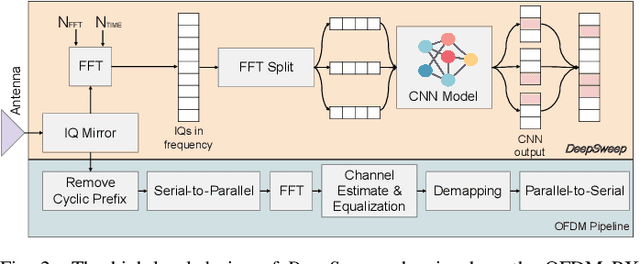
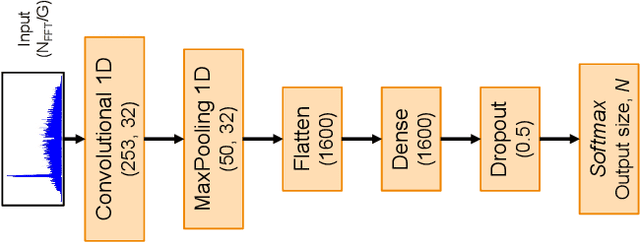

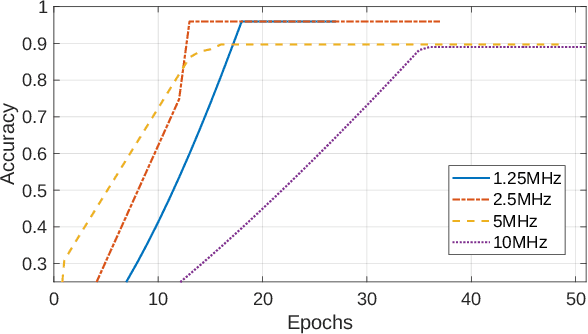
Abstract:Spectrum sensing is an essential component of modern wireless networks as it offers a tool to characterize spectrum usage and better utilize it. Deep Learning (DL) has become one of the most used techniques to perform spectrum sensing as they are capable of delivering high accuracy and reliability. However, current techniques suffer from ad-hoc implementations and high complexity, which makes them unsuited for practical deployment on wireless systems where flexibility and fast inference time are necessary to support real-time spectrum sensing. In this paper, we introduce DeepSweep, a novel DL-based transceiver design that allows scalable, accurate, and fast spectrum sensing while maintaining a high level of customizability to adapt its design to a broad range of application scenarios and use cases. DeepSweep is designed to be seamlessly integrated with well-established transceiver designs and leverages shallow convolutional neural network (CNN) to "sweep" the spectrum and process captured IQ samples fast and reliably without interrupting ongoing demodulation and decoding operations. DeepSweep reduces training and inference times by more than 2 times and 10 times respectively, achieves up to 98 percent accuracy in locating spectrum activity, and produces outputs in less than 1 ms, thus showing that DeepSweep can be used for a broad range of spectrum sensing applications and scenarios.
A Comparative Analysis of Deep Reinforcement Learning-based xApps in O-RAN
Sep 11, 2023



Abstract:The highly heterogeneous ecosystem of Next Generation (NextG) wireless communication systems calls for novel networking paradigms where functionalities and operations can be dynamically and optimally reconfigured in real time to adapt to changing traffic conditions and satisfy stringent and diverse Quality of Service (QoS) demands. Open Radio Access Network (RAN) technologies, and specifically those being standardized by the O-RAN Alliance, make it possible to integrate network intelligence into the once monolithic RAN via intelligent applications, namely, xApps and rApps. These applications enable flexible control of the network resources and functionalities, network management, and orchestration through data-driven control loops. Despite recent work demonstrating the effectiveness of Deep Reinforcement Learning (DRL) in controlling O-RAN systems, how to design these solutions in a way that does not create conflicts and unfair resource allocation policies is still an open challenge. In this paper, we perform a comparative analysis where we dissect the impact of different DRL-based xApp designs on network performance. Specifically, we benchmark 12 different xApps that embed DRL agents trained using different reward functions, with different action spaces and with the ability to hierarchically control different network parameters. We prototype and evaluate these xApps on Colosseum, the world's largest O-RAN-compliant wireless network emulator with hardware-in-the-loop. We share the lessons learned and discuss our experimental results, which demonstrate how certain design choices deliver the highest performance while others might result in a competitive behavior between different classes of traffic with similar objectives.
 Add to Chrome
Add to Chrome Add to Firefox
Add to Firefox Add to Edge
Add to Edge